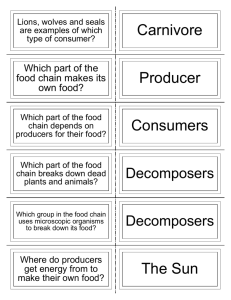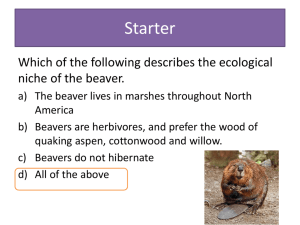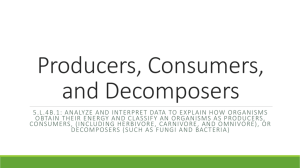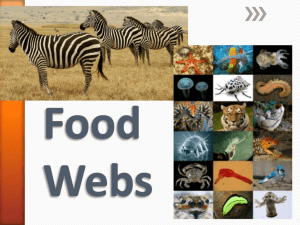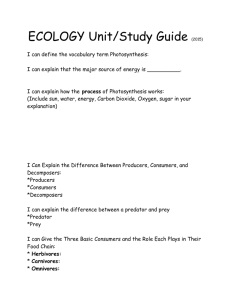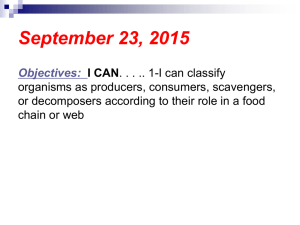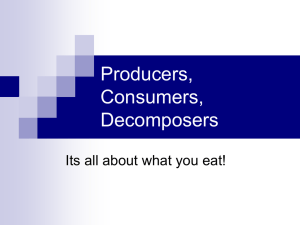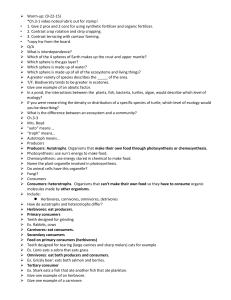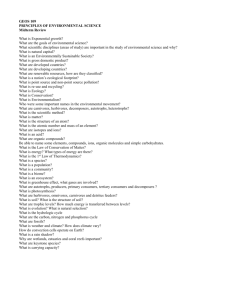Food Chains and Food Webs
advertisement
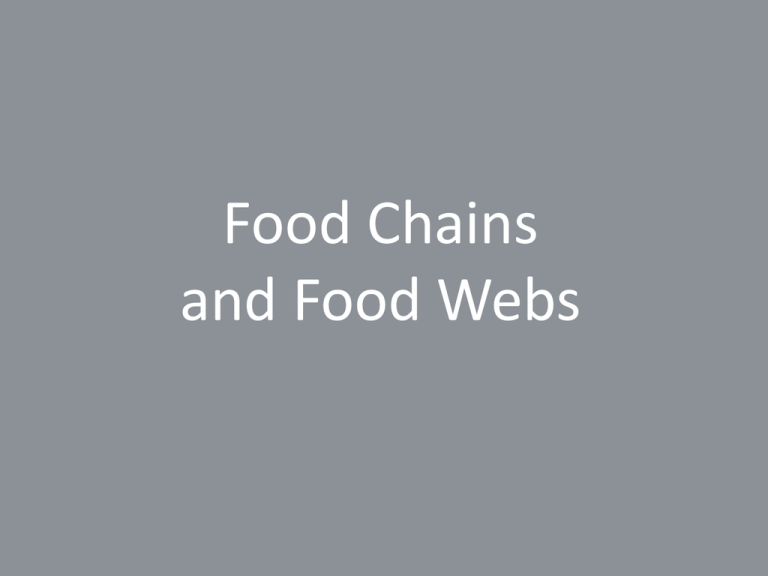
Food Chains and Food Webs What is a food chain? • A food chain is “a sequence of organisms, each of which uses the next, lower member of the sequence as a food source” A Basic Food Chain Plants absorb light from the sun, which is turned into energy to grow. We call these producers. The vegetarian animals eat the plants, they are called primary consumers. Secondary consumers prey on primary consumers. Important facts about food chains • In a food chain each organism obtains energy from the one at the level below. • Plants are called producers because they create their own food through photosynthesis. • Animals are consumers because they cannot create their own food, they must eat plants or other animals to get the energy that they need. Producers Producers are organisms that use energy from the Sun to make their own food through a process called photosynthesis. You can think of a producer as an organism that produces its own food. Most producers are plants. However, algae and some bacteria are producers, too. The grasses, shrubs, and trees in a meadow are examples of producers. These types of producers are common in grasslands and forest ecosystems. Algae are common producers in estuaries and marine ecosystems. Primary Producers • Primary producers are “organisms capable of producing their own food” • We can also say that they are photosynthetic, use light energy. • Examples of primary producers include algae, phytoplankton, and large plants. • Primary producers are eaten by primary consumers (herbivores) Primary Producers Cattails Bulrush phytoplankton Algae Consumers Some organisms must get energy by eating other organisms. These organisms are called consumers. Consumers can be organized into three groups: herbivores, carnivores, and omnivores. Three types of consumers • Herbivores: animals that eat only plants • Carnivores: animals that eat only other animals. • Omnivores: animals that eat animals and plants. Carnivores Carnivores are consumers that eat only other animals. In marine ecosystems, sharks, walruses, seals, and octopuses are common carnivores. In land ecosystems, lions, wolves, hawks, and eagles are common carnivores. Some carnivores are called scavengers. These carnivores eat animals that are already dead. Most of the time, scavengers eat leftovers from other carnivores. One example of a scavenger is a vulture. Omnivores Omnivores are consumers that eat both plants and animals. Since they can eat a variety of organisms, omnivores can easily adapt to changing environments. Pigs, bears, raccoons, and humans are examples of omnivores. Organisms such as fungi and bacteria get energy in a different way than producers or consumers. These organisms, called decomposers, get energy by breaking down nutrients in dead organisms. As they break down the nutrients, decomposers produce simple products such as water and carbon dioxide. These products are returned to the ecosystem for other organisms to use. Decomposers are very important because they return nutrients and products to the ecosystem. One way to think of decomposers is as recyclers. Termites and earthworms are examples of decomposers. Decomposers • Decomposers- are organisms that break down dead plant and animal matter into simpler compounds Other Ways to Classify Consumers 1. Primary Consumers: Herbivores. 2. Secondary Consumers: Carnivores that eat herbivores. 3. Tertiary Consumers: Carnivores that eat other carnivores. Primary Consumers in Marshes Muskrat (eats mostly Cattails) http://wdfw.wa.gov/wlm/living/graphics/muskrat1.jpg http://www.advancedwildlifecontrolllc.com/images/muskrat.jpg Primary Consumers in Marshes • Wood Duck eats seeds like those of the Swamp Marsh Mallow and Blue Flag Iris http://dsf.chesco.org/ccparks/lib/ccparks/wood_duck_pair.jpg Primary Consumers in Marshes • Glassy-winged Toothpick Grasshopper – eats leaves of plants like cattail and pickerelweed http://bugguide.net/node/view/41662 Secondary Consumers • Black Rat Snake eats eggs of animals like wood duck http://www.bio.davidson.edu/projects/tate/Terms.htm Secondary Consumers • Swamp Sparrow eats seeds but also insects like the toothpick grasshopper http://www.jeaniron.ca/2007/SwampSparrow6645.jpg Tertiary Consumers • Eat other animals in marsh including snake and sparrow Osprey www.montereybay.com www.audubon.org Omnivore • Racoon eats seeds, fruits, insects, worms, fish, and frogs… and pretty much anything else they can get their paws on! What is a food web? A food web is “an interlocking pattern of food chains”
